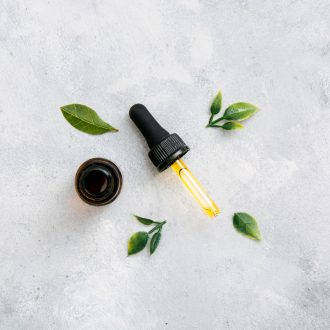- Empty cart.
- Continue Shopping
How to Incorporate Tea Tree Oil in Your Skincare Routine
How to Incorporate Tea Tree Oil in Your Skincare Routine 
Tea tree oil is a popular natural remedy known for its antibacterial, anti-inflammatory, and healing properties. It’s a great addition to a skincare routine, especially for those with acne-prone or oily skin. But tea tree oil can be potent, so knowing how to use it correctly is key to reaping its benefits without causing irritation. Here’s a guide on how to incorporate tea tree oil into your skincare routine for clear, healthy skin.
1. As a Spot Treatment for Blemishes
- Why It Works: Tea tree oil’s antibacterial properties help fight acne-causing bacteria. Its anti-inflammatory effects reduce redness and swelling, making it a powerful spot treatment for breakouts.
- How to Use: Dilute a few drops of tea tree oil with a carrier oil like jojoba or rosehip oil. Using a cotton swab, apply the mixture directly to blemishes. Leave it on overnight and rinse off in the morning. You can repeat this process daily until the blemish heals.
2. Add to Your Cleanser
- Why It Works: Incorporating tea tree oil into your cleansing routine can help control oil production and reduce acne flare-ups. It deep-cleans the skin, unclogs pores, and prevents bacteria from spreading.
- How to Use: Add 1-2 drops of tea tree oil to your regular cleanser. Gently massage the cleanser onto damp skin, focusing on oily or acne-prone areas. Rinse thoroughly with warm water and pat dry.
3. Use in a Face Mask
- Why It Works: Tea tree oil can enhance the purifying effects of a face mask. It helps draw out impurities from the skin while reducing redness and inflammation. This is especially beneficial for those with acne or oily skin.
- How to Use: Add 2-3 drops of tea tree oil to a clay or charcoal mask. Apply the mask evenly to your face, avoiding the eye area. Leave it on for 10-15 minutes and rinse with warm water. Use once or twice a week for best results.
4. Mix with Your Moisturizer
- Why It Works: If you’re dealing with persistent acne or oily skin, mixing tea tree oil with your moisturizer can help control breakouts without drying out your skin. It adds antibacterial power to your moisturizer, making it more effective at keeping your skin clear.
- How to Use: Mix 1-2 drops of tea tree oil with a non-comedogenic moisturizer. Apply it to your face after cleansing and toning. This method is great for daily use, as it helps prevent breakouts while keeping your skin hydrated.
5. Create a DIY Toner
- Why It Works: Tea tree oil’s ability to reduce oiliness makes it an excellent addition to a toner for acne-prone skin. A DIY tea tree oil toner can refresh your skin while helping to balance oil levels.
- How to Use: In a small spray bottle, mix 10 drops of tea tree oil with 1 cup of distilled water. Shake well before each use. Apply the toner to your face using a cotton pad or spray lightly onto clean skin. Follow with your moisturizer. Store the toner in a cool place, and use it within 1-2 weeks.
6. Use It as an Overnight Spot Mask
- Why It Works: Applying tea tree oil to pimples and leaving it on overnight allows it to work while you sleep, reducing inflammation and drying out active breakouts. This method is useful for treating stubborn blemishes.
- How to Use: Dilute tea tree oil with a carrier oil, or mix it with aloe vera gel for added soothing properties. Apply it directly to the pimple and let it work overnight. Wash it off in the morning.
7. Incorporate into a Steam Treatment
- Why It Works: Steaming opens up your pores, allowing tea tree oil to penetrate deeply and remove dirt, oil, and bacteria. This helps prevent future breakouts and leaves your skin feeling refreshed.
- How to Use: Add a few drops of tea tree oil to a bowl of steaming hot water. Lean over the bowl with a towel over your head to trap the steam. Let the steam work on your skin for 5-10 minutes. Afterward, rinse your face and apply a moisturizer.
8. Treat Oily Skin
- Why It Works: Tea tree oil helps regulate oil production, making it great for those with oily skin. When used consistently, it can help balance sebum levels and reduce excess shine.
- How to Use: Dilute a few drops of tea tree oil in a carrier oil or lightweight moisturizer. Apply it to oily areas of your face, such as your T-zone, after cleansing and toning.
Important Tips When Using Tea Tree Oil:
- Dilute Properly: Tea tree oil is potent and can cause irritation if applied directly to the skin. Always dilute it with a carrier oil or mix it into other skincare products.
- Do a Patch Test: Before using tea tree oil on your face, do a patch test on a small area of skin to ensure you don’t have an allergic reaction.
- Don’t Overuse: While tea tree oil is effective, using too much can cause dryness or irritation. Use it sparingly and avoid applying it to large areas of your skin.
Conclusion: Why Tea Tree Oil is a Skincare Essential
Tea tree oil’s antibacterial and anti-inflammatory properties make it a powerful addition to any skincare routine, especially for those with oily or acne-prone skin. Whether you use it as a spot treatment, mix it with your cleanser, or add it to a face mask, tea tree oil can help clear your skin, reduce inflammation, and prevent future breakouts. Just remember to dilute it properly and start with small amounts to avoid irritation.
Interested in creating your own product line? Explore our private labeling options and bring your brand vision to life. Fill out our Form to get started.
Discover more about our services by visiting our website.

